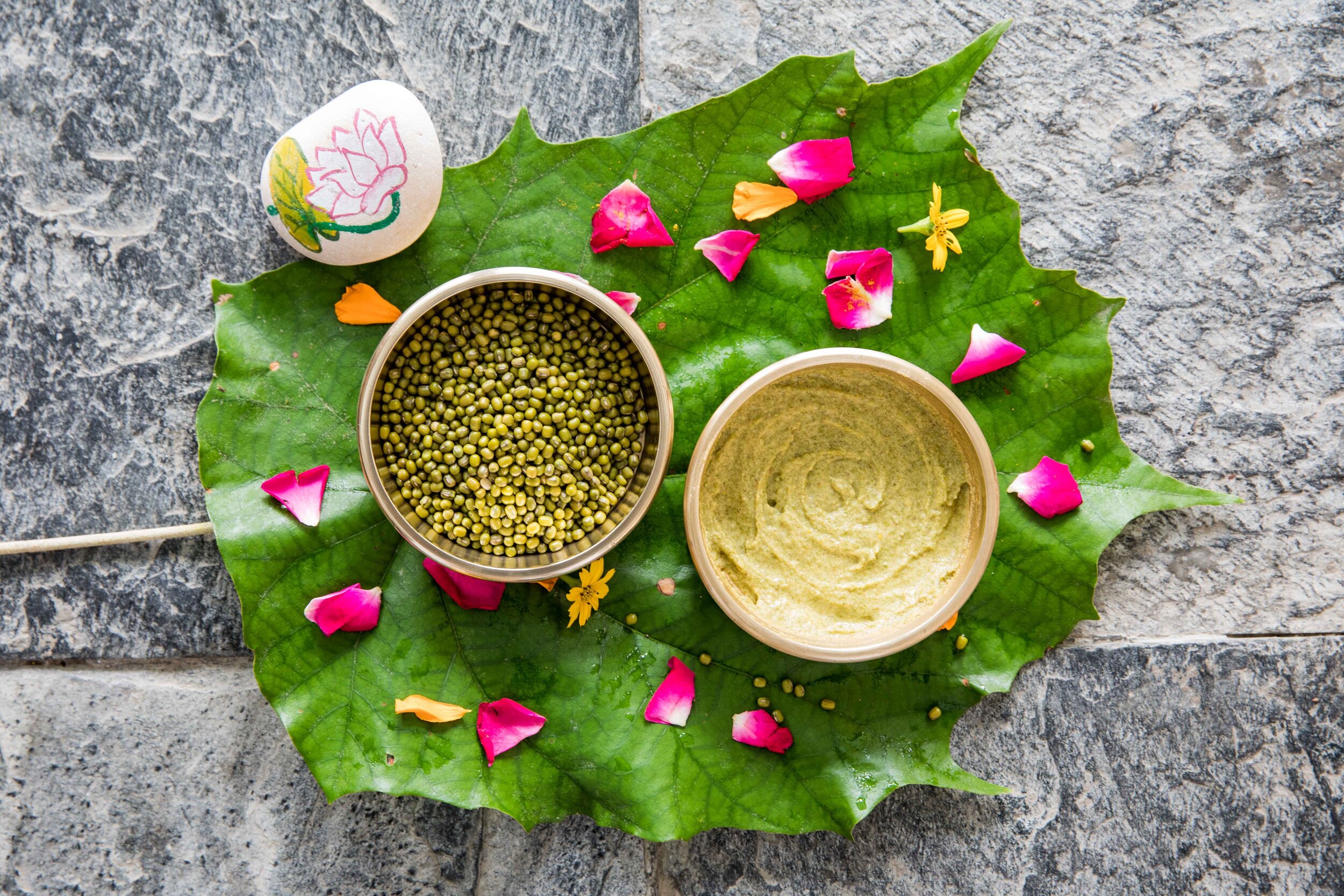HOW TO MAKE A MUNG BEAN SCRUB — AND WHY YOU SHOULD
You may not have heard about a mung bean scrub before, but it might just be what’s missing from your wellness routine. This DIY beauty secret can be used on your face or body and is great for the Kapha season — late winter and early spring — for a stimulating blast when feeling heavy and lethargic, in that gentle, Ayurvedic way.
This popular homemade scrub used throughout Asia is a great way to soothe dry and flaky skin and a kinder way to cleanse the skin than drying soaps and shower gels. It’s all natural, pH-balanced and hypoallergenic. Massaging in the shower or pre-bathing and post-Abhyanga with this scrub once or twice a week according to your skin type — Vata types tend to have fine and dry skin, Pitta types soft, lustrous and warm skin, and Kapha types soft, oily and lustrous — helps to remove any dead skin, enhance circulation and it’s also great for removing excess oil post-Abhyanga for Kapha types who don’t need it as much as, say, Vata types. Whether used on your face or body, this mung bean scrub enhances complexion, removes blemishes and adds glow to your skin, conditioning, soothing and deodorising, helping to cleanse off dead cells, dirt and excess sebum from the skin. It’s much more gentle than a sugar or salt scrub or those dreaded microbeads, all of which might feel good but are far too abrasive for most skin on the body and can be used every day, for those with a Kapha constitution. Treat yourself with this easy, simple and refreshing recipe to break down the impurities in the skin from the skin's surface, leaving your skin feeling nourished and silky smooth.
There are two methods of making a mung bean scrub — one is to make up a batch of powder which you can turn into a mildly abrasive paste as and when you need it — a great time-saver and super convenient. The other method is to soak a portion for immediate use and blend into a fresh paste, which I quite like as soaking the mung beans helps to activate the enzymes and has a less intense granular action on the skin, which is better suited for face, neck and decolletage where the skin is naturally thinner and usually more exposed to the elements. You’ll need a blender to make a mung bean scrub — a strong one works to grind the mung beans into a powder; otherwise a standard blender can be used to make the fresh paste for the body. If you only want to make just enough for the face then a small blender/spice grinder would work best for the small amount needed.
For the dry batch method
INGREDIENTS (feel free to double or triple the amount)
1 cup mung beans (green gram) or mung dal (yellow split mung)
¼ cup rice flour
1 tsp turmeric powder
METHOD
Using a strong blender (I use a Vitamix), grind the mung beans or dal to a fine powder with the rice flour. Add the turmeric and mix well. Store the mixture in an airtight container until needed.
For the body: Mix in your palm with some water to create a paste, and rub it on your body gently post-Abhyanga. Then rinse off and pat dry (do use a light sweep of oil again to moisturise if you’re a Vata type or feel that your skin needs it).
To make a face mask: Mix with one heaped teaspoon of the powder with 2 teaspoons or more of water, honey or yoghurt to create a thick paste, then relax with it on for 20-30 minutes before rinsing off thoroughly and then moisturising. NB: the powder should be ground very finely and well rehydrated with water, yoghurt, or honey. Avoid massaging into your face if it’s too thick/too grainy and not fine enough. As much as we are using it to gently slough the skin, you don’t want to overdo it (which is very easy to do!) and damage your skin even if “scrubbing” sounds and feels like a good thing.
East by West tip: Keep the powder clean, cool and dry. Use a spoon to remove what you are going to use to avoid contamination or damp seeping in.
For the fresh paste method
INGREDIENTS
½ cup of mung beans or mung dal
Water for soaking and grinding
METHOD
Soak mung beans overnight or mung dal in ¾ cup of water for at least an hour, then grind into a paste.
Apply it on your face and body and massage it gently into the skin for a few minutes. Let it stay on your body for 15 minutes, then wash it off.
For best results use after Abhyanga hot oil massage. This method can be used daily if it suits your skin.
East by West tips:
Do not repeat if irritation occurs. Avoid scrubbing scars, moles, spotty, broken, irritated or sunburnt skin.
If you like this, try the raw honey face mask, which can work wonders for your skin, acting as an anti-inflammatory and antibacterial, calming angry skin, moisturising, minimising dark spots and acne scars.
Related: Read more about bathing here, massage here, and garshana gloves here.

